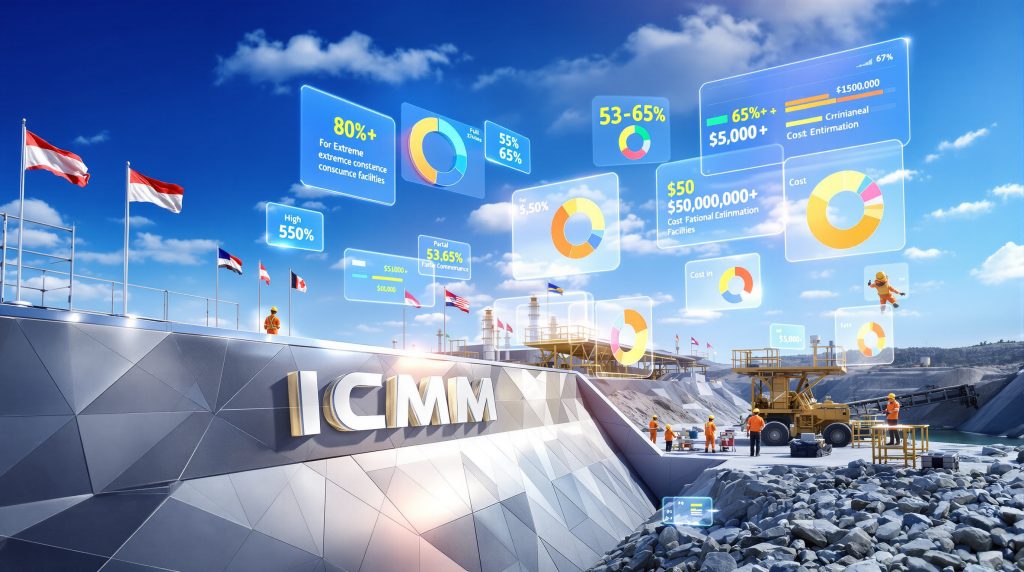Understanding ICMM's Global Industry Standard on Tailings Management Framework
The Global Industry Standard on Tailings Management (GISTM) represents a transformative milestone in mining safety protocols, fundamentally reshaping how the industry approaches tailings facility management. Published in 2020, this comprehensive framework emerged as a response to catastrophic tailings dam failures that highlighted critical gaps in global safety standards. Furthermore, the latest ICMM tailings compliance report reveals significant progress while acknowledging ongoing implementation challenges across the mining industry evolution.
Core Components of the GISTM Requirements
The GISTM framework encompasses 77 auditable requirements distributed across six operational domains, creating an integrated approach to tailings management that extends far beyond traditional engineering considerations. These requirements mandate systematic integration of social and environmental considerations throughout facility design phases, ensuring communities and ecosystems receive protection equivalent to technical safety measures.
Lifecycle management protocols form the backbone of GISTM compliance, establishing mandatory procedures spanning construction through final closure. This comprehensive approach recognizes that tailings facilities represent decades-long commitments requiring sustained oversight and adaptation as conditions evolve.
Independent verification and certification processes ensure objective assessment of conformance, removing potential conflicts of interest that previously compromised safety evaluations. Third-party auditors must demonstrate specialized qualifications and undergo regular recertification to maintain assessment authority.
Classification System for Tailings Facilities
The GISTM classification system categorizes facilities based on downstream consequence potential, creating a risk-based hierarchy that guides resource allocation and compliance prioritization. Extreme and very high consequence facilities receive highest priority due to catastrophic downstream impacts potential facility failures would generate.
Facility Classification Framework:
| Facility Classification | Risk Assessment Focus | Compliance Priority |
|---|---|---|
| Extreme Consequence | Maximum downstream impact potential | Immediate implementation required |
| Very High Consequence | Severe community and environmental risk | Priority implementation timeline |
| High Consequence | Significant regional impact scope | Standard implementation schedule |
| Significant Consequence | Moderate localized effects | Standard implementation schedule |
| Low Consequence | Limited downstream exposure | Standard implementation schedule |
Risk assessment methodologies determining facility rankings incorporate multiple variables including downstream population density, critical infrastructure proximity, environmental sensitivity, and potential economic impacts. These evaluations must undergo regular updating to reflect changing conditions surrounding facilities.
How Are Mining Companies Performing Against ICMM Tailings Standards in 2025?
Current ICMM tailings compliance report data reveals significant variation in implementation success across different facility classifications, highlighting the complex challenges companies face in achieving full conformance. The 2025 progress assessment encompasses 836 ICMM member facilities globally, providing the most comprehensive industry performance snapshot available.
Current Compliance Statistics Breakdown
ICMM Member Facility Compliance Rates:
| Facility Classification | Full Conformance Rate | Partial Conformance Rate | Total Facilities Impact |
|---|---|---|---|
| Extreme Consequence | 80%+ | <20% | Highest priority category |
| Very High Consequence | 80%+ | <20% | Accelerated timeline focus |
| High Consequence | 53-65% | 35-47% | Standard implementation |
| Significant Consequence | 53-65% | 35-47% | Standard implementation |
| Low Consequence | 53-65% | 35-47% | Standard implementation |
Overall industry statistics demonstrate that 67 percent of ICMM member facilities achieved full conformance with GISTM requirements, while 33 percent remain in partial conformance status as of late 2025. This performance distribution indicates substantial progress while acknowledging continued implementation challenges across approximately 276 facilities worldwide.
Timeline Challenges and Implementation Delays
The original August 2023 deadline established for extreme and very high consequence facilities reflected ambitious expectations that proved overly optimistic given implementation complexity. While these highest-risk facilities achieved greater than 80 percent full conformance rates, universal compliance remained elusive despite intensive corporate focus.
Extended August 2025 targets for remaining operations similarly encountered obstacles, with lower-consequence facilities achieving conformance rates ranging from 53 to 65 percent. These performance variations suggest that resource allocation strategies, technical complexity differences, and organisational capacity constraints significantly influence implementation success.
Industry Transformation Insight: The systematic changes required by GISTM implementation represent unprecedented organisational transformation within mining companies, fundamentally reshaping operational protocols and requiring substantial resource commitments across multiple operational domains.
What Specific Challenges Are Preventing Full GISTM Compliance?
Implementation barriers preventing universal GISTM conformance encompass technical, organisational, and financial dimensions that interconnect in complex ways. Understanding these challenges provides insight into why achieving full industry compliance requires extended timelines beyond initial projections.
Technical Implementation Barriers
Engineering upgrades required for existing infrastructure represent the most visible compliance challenge, often demanding complete redesign of critical facility components. Advanced monitoring system installations require integration with existing operational technology while maintaining continuous facility operation during transition periods.
Technical Upgrade Categories:
- Geotechnical stability assessments: Comprehensive subsurface analysis requiring specialised equipment and expertise
- Water management system enhancements: Integration of advanced treatment and containment technologies
- Structural reinforcement projects: Foundation strengthening and embankment modifications
- Monitoring network expansion: Installation of real-time sensors and data acquisition systems
Water management system enhancements often prove particularly complex due to site-specific hydrogeological conditions and regulatory requirements varying across jurisdictions. These upgrades must maintain operational continuity while implementing substantial infrastructure modifications, furthermore requiring comprehensive mining waste management strategies.
Organisational and Resource Constraints
Specialised personnel recruitment challenges reflect industry-wide shortages of qualified tailings management professionals, creating competition among companies for limited expertise. Training requirements extend beyond technical skills to encompass new risk assessment methodologies and stakeholder engagement protocols.
Resource Allocation Challenges:
- Capital investment prioritisation across multiple facility portfolios
- Multi-site coordination complexity for geographically dispersed operations
- Integration with existing procedures requiring systematic workflow redesign
- Stakeholder engagement expansion demanding new community relations capabilities
Multi-site coordination complexities multiply for large mining groups operating facilities across different regulatory jurisdictions, each with distinct local requirements and community expectations. These coordination challenges often extend implementation timelines beyond individual facility preparation requirements.
Which Mining Regions Show the Strongest ICMM Compliance Performance?
Geographic variations in GISTM conformance rates reflect complex interactions between regulatory frameworks, infrastructure availability, and local stakeholder engagement approaches. While comprehensive regional performance data requires additional industry disclosure, observable patterns suggest certain jurisdictions demonstrate superior implementation support systems.
Geographic Distribution of Conformance Rates
Established mining jurisdictions with mature regulatory frameworks generally demonstrate higher conformance rates due to existing infrastructure supporting technical implementation. Countries with established environmental assessment processes and experienced engineering consulting sectors provide operational advantages for companies pursuing GISTM compliance.
Regulatory environment influences on adoption speed vary significantly, with some jurisdictions actively supporting GISTM implementation through aligned policy frameworks while others maintain separate regulatory requirements creating dual compliance burdens.
Regional Performance Factors:
- Infrastructure development capacity for specialised engineering services
- Regulatory alignment with GISTM requirements reducing compliance complexity
- Local stakeholder engagement traditions affecting community consultation processes
- Financing institution requirements varying by regional banking practices
Industry Sector Variations in Compliance
Different commodity sectors face distinct technical challenges based on tailings composition characteristics and facility operational requirements. Base metals operations typically manage larger volume tailings streams with different geochemical properties compared to precious metals facilities.
Coal mining tailings management approaches require specialised consideration of combustion potential and acid mine drainage risks. Industrial minerals sector implementation strategies often benefit from lower-risk tailings characteristics but face unique processing and storage challenges, particularly when integrating modern mine planning and ESG considerations.
Commodity-Specific Implementation Factors:
- Tailings volume and composition affecting facility design requirements
- Processing technology integration with existing operational systems
- Environmental risk profiles varying by commodity extraction methods
- Market pressure timelines influencing capital allocation priorities
What Are the Financial and Operational Implications of GISTM Implementation?
GISTM compliance represents substantial financial commitments that vary dramatically based on facility characteristics, existing infrastructure condition, and local implementation requirements. Understanding these investment implications helps contextualise industry performance patterns and timeline challenges.
Investment Requirements for Full Compliance
Estimated Cost Categories for GISTM Implementation:
| Investment Category | Estimated Range | Variable Factors |
|---|---|---|
| Initial assessment and gap analysis | $50,000-$200,000 per facility | Facility size and complexity |
| Engineering design and planning | $200,000-$1,000,000 | Technical modification scope |
| Infrastructure upgrades | $1,000,000-$50,000,000+ | Existing condition and requirements |
| Ongoing monitoring and maintenance | $100,000-$500,000 annually | Technology sophistication level |
Note: These estimates reflect industry ranges and require verification from facility-specific assessments. Actual costs may vary significantly based on site conditions, regulatory requirements, and implementation timelines.
The dramatic variation in infrastructure upgrade costs reflects fundamental differences between facilities requiring minor modifications versus those needing comprehensive reconstruction. Facility consequence classification significantly influences investment requirements, with higher-risk facilities typically demanding more extensive modifications.
Risk Mitigation Benefits and Long-term Value
Catastrophic failure prevention represents the primary value proposition for GISTM investment, with potential liability exposure far exceeding compliance costs for most facilities. Enhanced stakeholder confidence generated through demonstrated commitment to international standards creates operational benefits extending beyond safety improvements.
Long-term Value Creation:
- Liability reduction through proactive risk management
- Stakeholder confidence enhancement supporting social licence maintenance
- Sustainable financing access improvement through ESG performance demonstration
- Operational efficiency gains via systematic management protocol implementation
Improved access to sustainable financing options increasingly influences corporate investment decisions as financial institutions integrate ESG criteria into lending requirements. Companies demonstrating GISTM conformance often receive preferential financing terms reflecting reduced risk profiles, consequently supporting broader sustainability transformation insights.
How Does the International Council on Mining and Metals Support Industry Progress?
ICMM functions as a coordination and knowledge-sharing platform rather than a regulatory enforcement body, facilitating industry-wide collaboration while maintaining transparency regarding member progress. The organisation's role encompasses data aggregation, best practice dissemination, and stakeholder engagement coordination across the global mining sector.
Independent Auditing and Certification Framework
Third-party verification protocols ensure objective assessment of GISTM conformance while maintaining consistent evaluation standards across diverse operational contexts. Auditor qualification requirements encompass specialised technical expertise and regular competency updates reflecting evolving industry practices.
Certification Framework Components:
- Auditor qualification programmes ensuring specialised competency
- Assessment methodology standardisation across different facility types
- Quality assurance mechanisms maintaining evaluation consistency
- Certification maintenance requirements supporting continuous improvement
The certification framework requires facilities to demonstrate sustained conformance rather than point-in-time compliance, recognising that tailings management represents ongoing operational requirements rather than one-time implementation projects.
Knowledge Sharing and Best Practice Development
Industry collaboration platforms facilitate experience sharing among member companies, enabling learning from both successful implementations and encountered challenges. Technical guidance document development draws upon collective member experience while incorporating evolving scientific understanding of tailings management.
Case study compilation and dissemination provides practical implementation examples helping companies navigate similar challenges. Research initiatives address persistent implementation obstacles while exploring innovative approaches to traditional tailings management challenges, including mine reclamation innovation strategies.
The 2025 tailings progress report represents ICMM's transparency commitment, aggregating individual member disclosures into comprehensive industry performance assessment. This annual reporting cycle enables trend identification and progress measurement across the global membership base.
What Lessons Can Be Learned from Leading ICMM Compliance Examples?
Successful GISTM implementation demonstrates consistent patterns in approach and resource allocation that other companies can adapt to their specific circumstances. Leading performers prioritise systematic planning, stakeholder engagement, and technology integration while maintaining operational continuity throughout transition periods.
Successful Implementation Case Studies
Prioritisation strategies focusing initial resources on highest-risk facilities enable companies to achieve meaningful safety improvements while building internal expertise for broader implementation. This risk-based approach aligns with GISTM classification systems while demonstrating tangible progress to stakeholders.
Implementation Success Factors:
- Early stakeholder engagement building community support for facility modifications
- Technology integration planning ensuring seamless operational transitions
- Resource allocation optimisation balancing immediate needs with long-term requirements
- Cross-functional team development combining technical and community relations expertise
Stakeholder engagement approaches that emphasise transparent communication and collaborative planning accelerate approval processes while building sustainable community relationships. Companies achieving rapid implementation typically invest significant resources in community consultation during early planning phases.
Common Implementation Pitfalls and Solutions
Underestimating timeline requirements for complex infrastructure upgrades represents the most frequent implementation challenge, with companies often discovering additional technical requirements during detailed engineering phases. Insufficient early-stage stakeholder consultation can create delays that extend far beyond technical implementation timelines.
Common Pitfalls and Solutions:
| Implementation Pitfall | Typical Impact | Recommended Solution |
|---|---|---|
| Timeline underestimation | 6-18 month delays | Comprehensive pre-implementation assessment |
| Stakeholder consultation gaps | Approval process delays | Early engagement with transparent communication |
| Resource allocation inadequacy | Partial implementation | Dedicated project teams with clear accountability |
| Technology selection challenges | Integration complications | Systematic vendor evaluation processes |
Remote operations face particular challenges implementing advanced monitoring requirements due to communication infrastructure limitations and maintenance access constraints. Successful remote implementations typically require redundant monitoring systems and specialised maintenance protocols.
How Will ICMM Tailings Standards Evolve Beyond 2025?
GISTM represents a foundational framework expected to undergo continuous evolution reflecting technological advancement, regulatory development, and accumulated operational experience. Future standard development will likely incorporate climate change considerations, circular economy principles, and emerging monitoring technologies.
Continuous Improvement Framework Development
Regular standard updates based on industry learning ensure GISTM remains relevant as technology and understanding advance. Emerging technology integration opportunities include artificial intelligence applications for predictive monitoring, advanced materials for facility construction, and automated reporting systems for regulatory compliance.
Evolution Areas:
- Climate change adaptation requirements for extreme weather resilience
- Circular economy integration promoting tailings reprocessing and beneficial use
- Technology advancement incorporation leveraging monitoring and automation capabilities
- Regulatory harmonisation aligning international standards with local requirements
Climate change adaptation considerations will likely become increasingly prominent as extreme weather events test facility resilience assumptions embedded in current design standards. Future requirements may mandate enhanced weatherproofing and emergency response capabilities.
Regulatory Alignment and Global Standardisation
Government policy harmonisation with GISTM requirements creates opportunities for streamlined compliance while reducing dual regulatory burden on mining companies. International financing institution adoption of GISTM standards increasingly influences project financing terms and investment decisions.
Supply chain integration of tailings management criteria extends responsibility beyond direct facility operators to include contractors, technology providers, and service companies. ESG reporting framework alignment initiatives ensure consistent performance measurement across different stakeholder groups.
Standardisation Trends:
- Government regulation alignment reducing compliance complexity
- Financial institution requirement integration standardising investment criteria
- Supply chain responsibility extension encompassing contractor performance
- ESG reporting harmonisation ensuring consistent performance metrics
What Steps Should Mining Companies Take to Accelerate GISTM Compliance?
Systematic approaches to GISTM implementation enable companies to optimise resource allocation while minimising operational disruption. Strategic planning emphasising risk-based prioritisation and stakeholder engagement produces superior outcomes compared to purely technical implementation approaches.
Strategic Planning and Resource Allocation
Recommended Implementation Roadmap:
- Comprehensive facility risk assessment identifying highest-priority upgrade requirements
- Gap analysis completion documenting specific conformance deficiencies across all facilities
- Prioritised upgrade scheduling based on consequence classification and resource availability
- Dedicated project team establishment with clear accountability and decision-making authority
- Stakeholder engagement programme development ensuring community consultation and regulatory alignment
- Technology vendor selection through systematic evaluation of capability and compatibility
- Phased implementation execution with milestone tracking and progress reporting
- Performance monitoring system deployment supporting continuous improvement requirements
Resource allocation optimisation requires balancing immediate safety improvements with sustainable long-term compliance maintenance. Companies achieving rapid progress typically establish dedicated implementation teams with cross-functional expertise and clear corporate support.
Building Internal Capabilities and Expertise
Specialised training programme development for operations teams ensures sustainable compliance capability beyond initial implementation phases. External consultant engagement addresses immediate expertise gaps while building internal knowledge through collaborative project execution.
Capability Development Priorities:
- Technical expertise enhancement through specialised training programmes
- Community relations skills development supporting stakeholder engagement requirements
- Project management capability building ensuring systematic implementation approaches
- Performance monitoring system operation maintaining ongoing compliance demonstration
Cross-functional collaboration protocols establishment ensures effective coordination between technical, environmental, community relations, and executive teams throughout implementation. Performance monitoring and reporting system implementation provides transparency supporting both internal management and external stakeholder communication.
Frequently Asked Questions About ICMM Tailings Compliance
What happens to companies that don't meet ICMM deadlines?
ICMM membership requirements emphasise commitment to GISTM implementation rather than imposing punitive measures for timeline delays. However, stakeholder and investor response implications can create substantial business consequences for companies demonstrating insufficient progress toward conformance.
Regulatory scrutiny and enforcement considerations vary by jurisdiction, with some governments incorporating GISTM requirements into local regulatory frameworks. Market access and financing impact assessments increasingly reflect ESG performance metrics that include tailings management standards.
How often must facilities undergo GISTM auditing?
Initial certification audit requirements establish baseline conformance assessment, with ongoing surveillance audit frequency determined by facility risk classification and performance history. Higher-consequence facilities typically require more frequent assessment intervals reflecting their elevated risk profiles.
Auditing Schedule Framework:
- Initial certification audits: Comprehensive conformance assessment
- Surveillance audits: Regular monitoring of continued compliance
- Recertification cycles: Periodic comprehensive reassessment
- Non-conformance follow-up: Targeted evaluation of corrective actions
Recertification cycles and renewal processes ensure sustained conformance rather than one-time compliance achievement. Non-conformance correction and follow-up procedures provide structured approaches for addressing identified deficiencies. Consequently, comprehensive documentation through ICMM's conformance framework provides transparency regarding progress and challenges.
Can smaller mining operations realistically achieve full compliance?
Scalable implementation approaches recognise that smaller operations face proportionally different resource constraints compared to large mining groups. Cost-sharing opportunities and industry collaboration models can provide access to specialised expertise and technology solutions otherwise unavailable to limited-resource operations.
Technology solutions appropriate for smaller operations often emphasise simplified monitoring approaches and standardised implementation procedures. Phased compliance pathways enable gradual capability building while demonstrating progress toward full conformance.
Small Operation Support Mechanisms:
- Shared service arrangements for specialised technical expertise
- Technology solutions scaled to operational size and complexity
- Implementation timeline flexibility accommodating resource constraints
- Industry collaboration opportunities facilitating knowledge sharing
This analysis reflects information available as of late 2025. GISTM requirements and industry performance metrics continue evolving as implementation experience accumulates and standards undergo regular review. Mining companies should consult current ICMM documentation and qualified professionals for specific compliance guidance applicable to their operational circumstances.
Want to Stay Ahead of Mining Industry Developments?
Discovery Alert's proprietary Discovery IQ model delivers real-time notifications on significant ASX mineral discoveries, ensuring you never miss actionable investment opportunities in companies implementing cutting-edge standards like GISTM. Start your 30-day free trial today and gain the market-leading advantage you need to capitalise on the mining sector's ongoing evolution.




